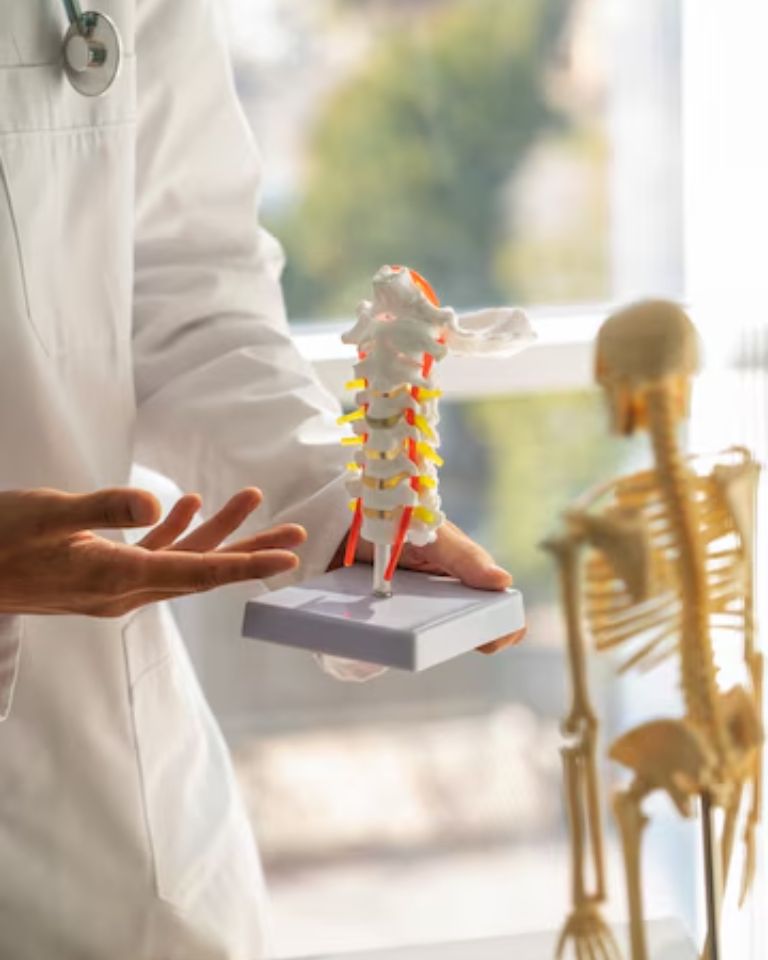
Spinal Fractures are breaks or cracks in the vertebrae, the bones that make up the spine. These fractures can result from trauma, such as car accidents or falls, as well as from conditions that weaken the bones, like osteoporosis. Symptoms of spinal fractures can include pain, difficulty moving, and possible neurological issues if the spinal cord is involved. Treatment may range from rest and pain management to surgical intervention, depending on the severity and location of the fracture.
Spinal fractures, also known as vertebral fractures, can occur due to trauma, osteoporosis, cancer, or other medical conditions affecting bone strength. These fractures can vary in severity, from mild compression fractures to more serious fractures that destabilize the spine. Spinal fractures, also known as vertebral fractures, can occur due to trauma, osteoporosis, cancer, or other medical conditions affecting bone strength. These fractures can vary in severity, from mild compression fractures to more serious fractures that destabilize the spine.
Spinal fractures can result from a variety of causes, each impacting the vertebrae in different ways. Trauma is one of the most common causes, often resulting from high-impact incidents such as car accidents, falls from significant heights, sports injuries, or direct blows to the back. These traumatic events can cause immediate and severe fractures, sometimes displacing the bone and potentially damaging the spinal cord or nerves.
In addition to trauma, medical conditions that weaken the bones significantly contribute to the incidence of spinal fractures. Osteoporosis, a condition characterized by reduced bone density and strength, is a leading cause, particularly among older adults. Individuals with osteoporosis can suffer fractures from minor falls or even from activities as simple as coughing or bending over. Other medical conditions, such as cancer that metastasizes to the spine, can also weaken the vertebrae, making them more susceptible to fractures. Infections of the spine, such as osteomyelitis, can deteriorate bone integrity, leading to fractures.
Additionally, lifestyle factors like poor nutrition, insufficient physical activity, smoking, and excessive alcohol consumption can adversely affect bone health, increasing the risk of fractures. Certain medications, particularly long-term use of corticosteroids, can also reduce bone density, making the spine more vulnerable. Genetic factors and family history of bone diseases further elevate the risk. Understanding the diverse causes of spinal fractures is crucial for prevention and management, as addressing these underlying factors can significantly reduce the incidence and impact of these debilitating injuries.

Spinal fractures, also known as vertebral fractures, refer to breaks or cracks in the bones (vertebrae) that make up the spine. These fractures can vary widely in severity, from mild compression fractures to more complex fractures that involve multiple vertebrae and potentially affect the stability of the spine. Understanding spinal fractures involves exploring their causes, types, symptoms, diagnosis, treatment options, and implications for patient care and recovery.
Spinal fractures, also known as vertebral fractures, can occur due to trauma, osteoporosis, cancer, or other medical conditions affecting bone strength. These fractures can vary in severity, from mild compression fractures to more serious fractures that destabilize the spine.
Causes: Spinal fractures commonly result from trauma such as falls, motor vehicle accidents, or sports injuries. In older adults, osteoporosis weakens bones, making them more susceptible to fractures from even minor trauma or stress. Certain cancers that metastasize to the spine can also weaken bones and lead to fractures.
Types:
Compression Fractures: These occur when a vertebral body collapses or compresses due to trauma or osteoporosis. They often cause pain and a loss of height.
Burst Fractures: These involve the vertebral body breaking into multiple fragments due to significant trauma, such as a fall from height or a car accident. Burst fractures can lead to spinal cord compression and neurological deficits.
Chance Fractures: These are flexion-distraction fractures where the spine is pulled apart due to excessive flexion, often seen in motor vehicle accidents with lap seatbelt injuries.
Pathological Fractures: These occur in weakened bone affected by underlying conditions such as cancer or infection.
Symptoms: Symptoms of spinal fractures include back pain, which may worsen with movement, difficulty standing or walking, loss of height, and deformity in severe cases. Neurological symptoms such as weakness, numbness, or tingling may occur if the fracture compresses spinal nerves or the spinal cord.
Diagnosis: Diagnosis typically involves imaging studies such as X-rays, CT scans, or MRI to visualize the fracture, assess its severity, and determine if there is any spinal cord or nerve compression.
Treatment Options:
Conservative Management: Mild fractures may be managed conservatively with pain medications, bracing, and physical therapy to help stabilize the spine and promote healing.
Minimally Invasive Procedures: For certain types of fractures, minimally invasive techniques such as vertebroplasty or kyphoplasty may be used. These procedures involve injecting bone cement into the fractured vertebra to stabilize it and relieve pain.
Surgery: Severe fractures with spinal instability or neurological deficits may require surgical intervention. Surgery aims to stabilize the spine, decompress nerves or the spinal cord, and restore spinal alignment.
Spinal fractures can present with a range of symptoms, varying in severity depending on the fracture’s location and extent. One of the most common symptoms is acute, localized back pain, which can be intense and sharp or dull and aching. This pain often worsens with movement, standing, or sitting and may improve with rest. In some cases, the pain can radiate to other areas, such as the hips or legs. Alongside pain, individuals may experience limited mobility and difficulty performing daily activities due to discomfort or fear of exacerbating the injury. Neurological symptoms can also arise if the spinal cord or nerves are affected. These symptoms might include numbness, tingling, or weakness in the arms or legs, which can indicate nerve compression. In severe cases, spinal fractures can lead to more serious complications such as loss of bowel or bladder control, which requires immediate medical attention. Additionally, individuals with spinal fractures might notice a noticeable change in posture or a hunching of the back, particularly with vertebral compression fractures. Such fractures can lead to a loss of height and an abnormal curvature of the spine over time. Overall, prompt recognition and evaluation of these symptoms are crucial to prevent further complications and to begin appropriate treatment.
Spinal fractures are classified into several types based on their cause, location, and the nature of the injury:
Compression Fractures: These are the most common type of spinal fractures and occur when the front part of a vertebra collapses, often due to osteoporosis. This type of fracture usually results in a wedge-shaped deformity of the vertebra.
Burst Fractures: This type of fracture involves the vertebra breaking into multiple fragments. It often results from a severe trauma, such as a car accident or a high fall. Burst fractures can be more complex and may cause spinal cord injury or nerve damage.
Flexion-Distraction Fractures: Also known as chance fractures, these occur when the spine is forced into extreme flexion, often from high-speed impacts or sudden decelerations, such as in a car accident. This type of fracture involves a combination of vertebral body fractures and posterior element injuries.
Fracture-Dislocations: These are severe injuries where a vertebra not only fractures but also dislocates, causing significant misalignment of the spine. This type often results from high-energy trauma and can lead to severe neurological impairment if the spinal cord is compressed.
Odontoid Fractures: These occur specifically in the second cervical vertebra, known as the odontoid process or axis. Odontoid fractures can result from high-impact trauma and may disrupt the stability of the upper cervical spine, impacting the ability to move the head and neck.
In conclusion, spinal fractures represent a spectrum of injuries with diverse causes, ranging from trauma and osteoporosis to underlying medical conditions like cancer and infections. Effective management requires a thorough understanding of the fracture type, severity, and associated symptoms. Prompt diagnosis through imaging studies and comprehensive evaluation by specialists such as neurosurgeons and neurologists is crucial for determining the most appropriate treatment approach.
For individuals in Indore seeking specialized care for spinal fractures, consulting a neurosurgeon or neurologist experienced in spine injuries, such as a neurosurgeon in Indore, is essential. These specialists in Indore can provide expertise in diagnosing spinal fractures, offering personalized treatment plans that may include conservative measures, minimally invasive procedures like vertebroplasty or kyphoplasty, or surgical interventions when necessary. Their focused approach not only aims to alleviate pain and restore spinal function but also prioritizes patient safety and long-term recovery. This ensures that patients receive comprehensive care tailored to their specific condition and needs.
Whether addressing fractures from trauma, osteoporosis, or complex spinal conditions, accessing skilled care from neurosurgeons or neurologists in Indore ensures comprehensive management tailored to individual needs. By collaborating with these specialists, patients can expect compassionate support throughout their treatment journey, optimizing outcomes and enhancing quality of life.